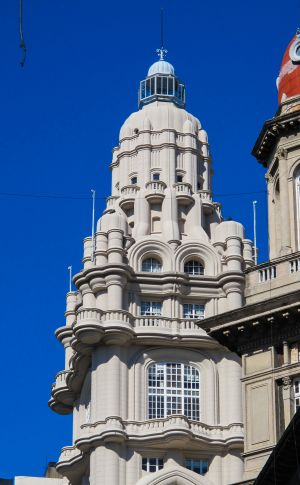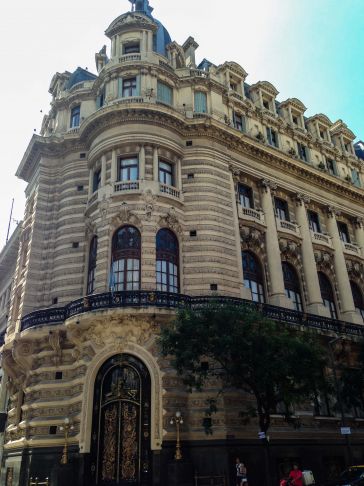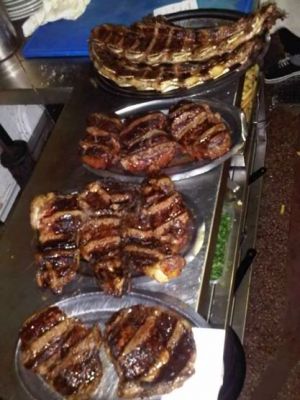Buenos Aires: Funky, Cool, Delicious
May 25, 2015
Buenos Aires baby! The Paris of South America, or so they say. Everything you read about Buenos Aires (BsAs for short) touts its long and interesting history as well as its reputation as South America’s greatest city. Postcards show photos of grand architecture and quaint cafes and gin-joints where people listen to Spanish beats and dance Tango late into the night. Sure enough, it was everything I hoped for but I don’t know, I didn’t absolutely love it as much as I hoped.
Buenos Aires is beautiful but a bit of a hodgepodge. There’s a distinct “we want to be European” thing going on in BsAs and you see it in the architecture, life-styles, foods and heritage of the people, many of whom are immigrants from Italy, Spain, and other old-world nations. I’ll try to cover the BsAs I know but honestly, there’s so much to discuss, I could never put into a single post.
The architecture may be the most telling attribute of Buenos Aires’ long-standing desire to recreate the cities that it idolizes. On one side of a street you might have a long row of buildings that make you think “look, it’s just like Paris” and on the other side, some crappy 1970’s rusting high-rise with dripping AC units sticking out of every window, and then there’s the awesome stone Art Deco building standing handsomely on the corner. Jen referred to it as an interesting juxtaposition that kind of makes the beautiful building stand out, I call it completely maddening. I want to shake the people building the crap piles that have been erected between the beautiful buildings and shout “get ahold of yourself,” like that scene from the movie “Airplane.” Despite the eyesore buildings and the attempts at being more European, there’s an Argentine influence on everything. For example, instead of a Parisian building being four floors with servant quarter’s occupying the attic, these ones are five or six floors, sometimes more. It’s like someone wanted to recreate the building in Paris but couldn’t resist the urge to supersize them. You have the Palacio Barolo which is a structure based on the number 22; influenced by the number of stanzas in Dante’s Devine Comedy. They say each floor depicts the visitor’s journey through hell, purgatory and then paradise. It’s so cool that it influenced the style of all the buildings around it with the exception of the shamelessly built, dingy high-rise apartment building on the corner that clearly doesn’t care it’s one of the worst buildings on the whole street.
 |
 |
| Top of the Palicio Barolo. The same architect built the same building in Uruguay. | An example of the mixed architecture used in Buenos Aires. What's missing from this picture is the dingy office building nextdoor. |
When it comes to food, BsAs has got some pretty great eats, and like the architecture you’ve got a smattering of everything. You can gorge yourself on empanadas, good pizza, choripan (Spanish chorizo sausage on a hard role with toppings), hand-made Italian pastas and piles of delicious meat all on the same block. The most popular dining experience for visitors, however, is the Parrilla. These are basically steak houses that specialize in serving massive amounts of expertly grilled meats over blazing hot wood coals. You can go high-end, mid-range, or low-end on the price scale with these places and be guaranteed to leave satisfied and overloaded with protein. We picked our budget and went to a place named Parrilla Peña. It was certainly on the lower side in terms of pricing (we paid about $15 per person) but lacked nothing in quality. We enjoyed a massive wheel of grilled cheese, two nice cuts of meat with sides, two types of sausages, and two bottles of wine. You’re probably thinking “holy shit, how did you do that for $30!?” We ate with some friends we met in Uruguay and split the bill. Like the little orange guys from “Willy Wonka and the Chocolate Factory” though, we awkwardly waddled out of the place with over-stretched bellies and no desire to eat meat for at least a few days. It was utterly fantastic.

To wrap-up such massive and often carnivorous meals in BsAs you can drop by any one of the excellent ice-cream parlors that seem to be everywhere. For the true rock stars you can also go for the nightcap and enjoy some excellent artisanal brews at places like Antares (named after the star) or other popular bars around the city. Our preferred nightly ritual usually involved buying unbelievably cheap and decent wines, and strolling around town. On one such occasion we even got to sit outside and listen to the Buenos Aires Orchestra play a free open-air show. It was without question my favorite experience in BsAs and one of the top ten of our trip so far.
As for the people in BsAs, Porteños as they are commonly called, are pretty fine folk. I can’t honestly say I met a bunch of locals but those I did meet and come in contact with were laid back, open to conversation and generally nice. A tour guide we went with on a Free Walking Tour said Poretños can be a little moody and often expressive of their beliefs but not in an offensive way. They might spray paint the hell out of everything when their blood gets up about an issue but they tend to be proud and passionate.
Another unique attribute about BsAs and Argentina as a whole at the moment is the “blue market” money exchangers. The blue market as it’s called is basically a black market but for money; you bring dollars or euros and buy Argentine Pesos at a more favorable rate than the official exchange rate. Yep you heard me right, if the official exchange rate is eight pesos to one US dollar, you can head over to the blue market and get twelve pesos. Why? Simple, the Argentine peso aint so good. It suffers from hyperinflation hovering around 30% and is quite unstable, so Argentinians looking to save some money trade their pesos for dollars or euros to have a more stable savings account. But I digress, we arrived with nothing but lint in our pockets and a debit/ATM card that was acting up so we needed the help of the “Arbolitos” or “little trees” as they are commonly referred to for their static position in certain areas where they hold green US bills that flutter like leaves on a tree. You can find these guys on pedestrian walks and outside of small shops squawking like crows the word “combio, combio” which is Spanish for “change, change.” We approached several and bargained a bit before settling on a guy who both gave us a decent rate and didn’t seem like he might club us in a back alley and run off with our cash. We exchanged about $200 USD but because they were smaller bills ($20’s) we didn’t get the absolute best price. Later we exchanged some Euros and US one hundred dollar notes for a sizable profit.
So all of this sounds pretty darn good, right? Good food, cheap wine, interesting architecture, favorable cash exchange situation and some excellent people, what’s not to like? How am I not madly in love with the place? To be honest, I really don’t know. Maybe it was just overly hyped up in my mind. Maybe I spent too many nights full of good food and cheap wine. Whatever it is, it certainly won’t stop me from coming back and shouldn’t stop you from checking it out. With that in mind, let me drop some advice nuggets on you for your next visit to Buenos Aires to wrap this up.
- Walk everywhere. Seriously, the distances can be long but you get to see so much more on foot assuming you have the time. Just try to pick one or two neighborhoods per day to avoid crisscrossing the city all day covering more ground but seeing less.
- Bring plenty of US dollars or Euros and remember, the larger the note, the better the rate. (This may change with the next President)
- Don’t associate expensive with the best when it comes to the Parrillas. Everyone should visit at least one Parrilla in Buenos Aires and there are deals to be found if you do a little research and ask around but you’ll have a tough time finding a bad one.
- Be careful with your belongings. This should be pretty obvious but Buenos Aires has a tendency to turn you into a gawking, photo snapping gringo leaving your senses a little dull. We had two friends who were robbed in broad daylight about 15 meters from a uniformed police officer. They weren’t in the best area but one that is frequented by visitors and in my experience, seemed pretty safe.
- Get outside at night and walk around until at least mid-night, especially on the weekends. Argentina as a whole loves their siestas which changes their schedules a bit. Dinner is often at 8:00 or 9:00 at night at the earliest and things don’t really get going until well after 2:00am. If you take a stroll in the evening you’re likely to come across some nice little event happening in one of the many excellent neighborhoods. Again, be safe.
- Get wine. It doesn’t matter if you’re heading to wine country or not, in Beunos Aires you need to have some red wine with or without a meal and there’s plenty to choose from. Many of the wines produced throughout the country make their way to BsAs and you’ll find a great selection at reasonable prices all around the city.
Please add a comment
Leave a Reply
Category List
Resources (6)
Photo Album (35)
Accommodations (8)
Products (11)
Activities (11)
Food (9)
Places (24)
Tag List
Planning Your Trip (1)
Travel (4)
Scuba Diving (1)
Recommendations (2)
Mexico (1)
Travel Workout (1)
Traveling into Panama (1)
pack, Deuter, Gregory, women (1)
Tulum Ruins (1)
Tours (2)
Waterfalls (1)
Flores (1)
Salt Flats (2)
Career Break (2)
Hostels (4)
Stretch your money (1)
Nicaragua (1)
Cotopaxi (1)
Biking (1)
birth control (1)
Mini-retirement (1)
RTW Travel (9)
RTW travel for women (4)
Utila (3)
Yoga (1)
Caye Caulker (1)
Living abroad (1)
birth control and traveling (1)
Tulum (1)
Central America (2)
Guatemala (1)
Family (2)
Panama (2)
Budgeting for travel (1)
Sunday Funday (1)
Hiking (2)
Bolivia (2)
Costa Rica (1)
Belize (1)

